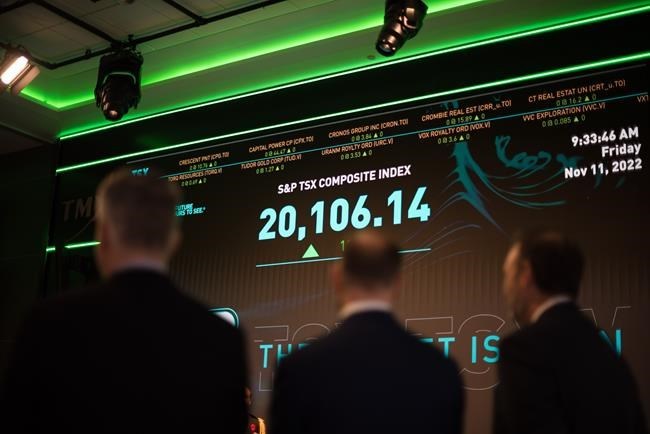OTTAWA — Investors had few places to hide this year.
As of closing Wednesday, Canada's main stock index has dropped 12 per cent from the all-time high it hit in the spring. Bond markets, which typically move in the opposite direction to stocks, also fell sharply after central banks around the world aggressively raised interest rates to curb rising inflation.
The pressure is unlikely to let up heading into 2023. The U.S. Federal Reserve has suggested interest rates may continue to rise and further hikes from the Bank of Canada are on the table, too. Investors face the possibility of a recession and what that will mean for corporate profits already being squeezed by rising costs.
Looking back over the past 12 months Brent Joyce, chief investment strategist at BMO Private Investment Counsel Inc., said it was one of the worst ever years for a combined portfolio of stocks and bonds.
"It was a perfect storm," he said.
Joyce said investors had adjust to what he called more normal conditions with the end of near zero per cent interest rates and a return to risk for stocks.
The year didn't start off poorly for the Toronto Stock Exchange.
As oil prices soared with Russia's invasion of Ukraine, the commodities-heavy S&P/TSX composite index climbed. With the price of oil over US$100 a barrel for the first time in years, Canada's main stock index posted a record close on March 29 when it ended the trading day at 22,087.22 and went on to reach an intraday high of 22,213.07 on April 5.
However, sentiment turned as inflation gained traction and central banks shifted gears and began raising interest rates from the emergency lows where they had been set at the start of the pandemic.
In response, stock markets lost steam and started to backpedal. The S&P/TSX composite hit a closing low for the year at 18,206.28 on Oct. 12 followed by an intraday low of 17,873.18 a day later on Oct. 13. Though it has climbed above the 19,500 mark over the past few months, a December stock boost has failed to materialize this year.
Mona Mahajan, senior investment strategist at Edward Jones, said higher interest rates put pressure on stock valuations, especially for those sectors where they run high.
"Areas like technology and growth, more speculative asset classes, all really took an outsized hit in 2022," she said.
Some tech companies saw growth during the pandemic that supported those valuations, Mahajan said, but the trends started to cool during the reopening phase.
Mahajan said usually in a down year for stocks, you can rely on your bond portfolio to kind of provide some diversification, but that wasn't the case this year.
"The rapid move in interest rates, the elevated inflation, all put downward pressure on stocks and bonds," she said.
One of the few bright spots for the Canadian market was the energy sector.
"The two most unloved investment opportunities of the past 10 years would be cash and energy stocks. And they have, you know, risen like a phoenix from the ashes to be this year's winners," Joyce said.
Headed into the new year, economic headwinds remain as economists point to the possibility of a recession to start the year.
Mahajan also said risks around inflation remain even though it has shown signs of cooling in recent months. She cautioned inflation could be stickier than expected if supply issues prove harder to solve or if demand remains strong and keeps prices elevated.
"That's probably the biggest among most of the risks we’re seeing out there," she said.
But Mahajan said markets are forward looking, so 2023 should offer a better backdrop for stocks and bonds after what she expects to be a mild recession as we move through the economic turmoil.
She said the energy sector was the clear winner in 2022, but traditional value and defensive sectors like consumer staples, utilities and health care have also held up well.
"As we kind of get through the first quarter or two quarters of 2023 we do think that those parts of the market may continue," she said.
"But as we look toward what we call the recovery playbook, that is where we start to see better performance out of quality growth (stocks), out of areas like cyclicals," she said.
Joyce was also positive about 2023 as he said capital markets have already spent a year adjusting to the new reality of inflation, higher interest rates, slowing growth and increased geopolitical tensions.
He said a lot of complacency has been scrubbed from the system and the reset to higher bond yields is closer to the end than the beginning.
"Many equity and bond markets have come a long way toward adjusting to the current reality," he said.
"Looking ahead, we see better investment opportunities today than we did a year ago."
This report by The Canadian Press was first published Dec. 22, 2022.
Craig Wong, The Canadian Press



